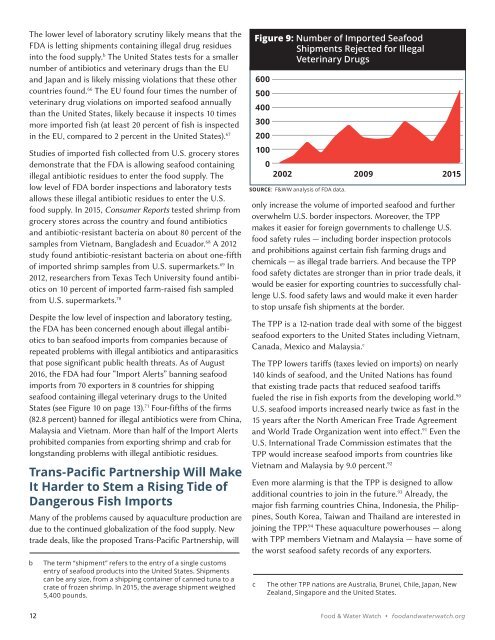TOXIC BUFFET
rpt_1609_tpp-fish-web
rpt_1609_tpp-fish-web
You also want an ePaper? Increase the reach of your titles
YUMPU automatically turns print PDFs into web optimized ePapers that Google loves.
The lower level of laboratory scrutiny likely means that the<br />
FDA is letting shipments containing illegal drug residues<br />
into the food supply. b The United States tests for a smaller<br />
number of antibiotics and veterinary drugs than the EU<br />
and Japan and is likely missing violations that these other<br />
countries found. 66 The EU found four times the number of<br />
veterinary drug violations on imported seafood annually<br />
than the United States, likely because it inspects 10 times<br />
more imported fish (at least 20 percent of fish is inspected<br />
in the EU, compared to 2 percent in the United States). 67<br />
Studies of imported fish collected from U.S. grocery stores<br />
demonstrate that the FDA is allowing seafood containing<br />
illegal antibiotic residues to enter the food supply. The<br />
low level of FDA border inspections and laboratory tests<br />
allows these illegal antibiotic residues to enter the U.S.<br />
food supply. In 2015, Consumer Reports tested shrimp from<br />
grocery stores across the country and found antibiotics<br />
and antibiotic-resistant bacteria on about 80 percent of the<br />
samples from Vietnam, Bangladesh and Ecuador. 68 A 2012<br />
study found antibiotic-resistant bacteria on about one-fifth<br />
of imported shrimp samples from U.S. supermarkets. 69 In<br />
2012, researchers from Texas Tech University found antibiotics<br />
on 10 percent of imported farm-raised fish sampled<br />
from U.S. supermarkets. 70<br />
Despite the low level of inspection and laboratory testing,<br />
the FDA has been concerned enough about illegal antibiotics<br />
to ban seafood imports from companies because of<br />
repeated problems with illegal antibiotics and antiparasitics<br />
that pose significant public health threats. As of August<br />
2016, the FDA had four “Import Alerts” banning seafood<br />
imports from 70 exporters in 8 countries for shipping<br />
seafood containing illegal veterinary drugs to the United<br />
States (see Figure 10 on page 13). 71 Four-fifths of the firms<br />
(82.8 percent) banned for illegal antibiotics were from China,<br />
Malaysia and Vietnam. More than half of the Import Alerts<br />
prohibited companies from exporting shrimp and crab for<br />
longstanding problems with illegal antibiotic residues.<br />
<br />
It Harder to Stem a Rising Tide of<br />
<br />
Many of the problems caused by aquaculture production are<br />
due to the continued globalization of the food supply. New<br />
trade deals, like the proposed Trans-Pacific Partnership, will<br />
b<br />
The term “shipment” refers to the entry of a single customs<br />
entry of seafood products into the United States. Shipments<br />
can be any size, from a shipping container of canned tuna to a<br />
crate of frozen shrimp. In 2015, the average shipment weighed<br />
5,400 pounds.<br />
Figure 9: Number of Imported Seafood<br />
Shipments Rejected for Illegal<br />
Veterinary Drugs<br />
600<br />
500<br />
400<br />
300<br />
200<br />
100<br />
0<br />
2002 2009 2015<br />
SOURCE: F&WW analysis of FDA data.<br />
only increase the volume of imported seafood and further<br />
overwhelm U.S. border inspectors. Moreover, the TPP<br />
makes it easier for foreign governments to challenge U.S.<br />
food safety rules — including border inspection protocols<br />
and prohibitions against certain fish farming drugs and<br />
chemicals — as illegal trade barriers. And because the TPP<br />
food safety dictates are stronger than in prior trade deals, it<br />
would be easier for exporting countries to successfully challenge<br />
U.S. food safety laws and would make it even harder<br />
to stop unsafe fish shipments at the border.<br />
The TPP is a 12-nation trade deal with some of the biggest<br />
seafood exporters to the United States including Vietnam,<br />
Canada, Mexico and Malaysia. c<br />
The TPP lowers tariffs (taxes levied on imports) on nearly<br />
140 kinds of seafood, and the United Nations has found<br />
that existing trade pacts that reduced seafood tariffs<br />
fueled the rise in fish exports from the developing world. 90<br />
U.S. seafood imports increased nearly twice as fast in the<br />
15 years after the North American Free Trade Agreement<br />
and World Trade Organization went into effect. 91 Even the<br />
U.S. International Trade Commission estimates that the<br />
TPP would increase seafood imports from countries like<br />
Vietnam and Malaysia by 9.0 percent. 92<br />
Even more alarming is that the TPP is designed to allow<br />
additional countries to join in the future. 93 Already, the<br />
major fish farming countries China, Indonesia, the Philippines,<br />
South Korea, Taiwan and Thailand are interested in<br />
joining the TPP. 94 These aquaculture powerhouses — along<br />
with TPP members Vietnam and Malaysia — have some of<br />
the worst seafood safety records of any exporters.<br />
c<br />
The other TPP nations are Australia, Brunei, Chile, Japan, New<br />
Zealand, Singapore and the United States.<br />
12 Food & Water Watch • foodandwaterwatch.org


